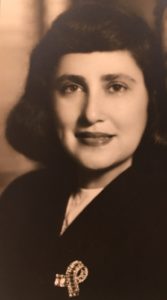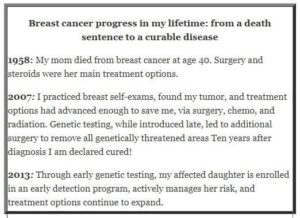Celebrating Science and Self-Advocacy in Marking My Ten-Year Breast Cancer “Cure” Milestone
Betsy Bassan, October 15, 2017

My mother, Celeste Franklin Bassan, wearing the breast cancer symbol, before it was even invented.
My passion for supporting breast cancer awareness and research comes from my own personal experience. Here’s my story, which I think is important to share. I hope it helps someone else!
Breast cancer has shaped my and my family’s life for at least three generations. What I learned from this family history of cancer is that each of us must be our own best advocates—focused on early detection, performing self-exams, and speaking up for ourselves in healthcare settings. We also must be ever grateful for the medical advances that make treatment options and survival rates better each year.
My mother’s breast cancer story. My mother was diagnosed with breast cancer when I was two and died shortly after I turned four, on Jan. 4, 1958, just shy of her 41st birthday on Valentine’s Day.
Surgery and steroids were the key treatment options in those days. Unfortunately, surgery didn’t come soon enough as the cancer had already spread. Over a painful couple of years, the cancer spread, slowly debilitating my remarkably vibrant mom, who eventually became bedridden before passing. She left five kids ages 4 to 11 and my dad, a doctor who never fully recovered from his grief of losing her and his guilt of failing to save her.
My breast cancer story. The prospect of breast cancer hung over my head throughout my life like Damocles’ sword. I labored under a foreboding sense that it could strike at any minute. My greatest fear was leaving my three kids without a mom, forsaken to my family’s experience. This fear was so great that my mind would stop processing as soon as the topic arose. Amazing as it now seems, my gynecologist never suggested genetic testing to see what my real risk was.
One thing that did resonate was the need for regular breast self-exams, possibly a result of a graphic breast self-exam demonstration in college in which the demo breast was lovingly, but quite embarrassingly, called “Betsy breast.”
Besides regular mammograms, I kept a plasticized set of breast self-exam directions on my showerhead, trying my best to track a monthly course. During a self-breast exam in October 2007, at age 53 and six months after a clean mammogram, I found a lump in my right breast. My internist quickly got me into a surgeon’s office for a biopsy. My fear was incalculable. My very kind surgeon said he didn’t think the lump felt like cancer. I was convinced otherwise and unsurprised when two days later he told me it was indeed a malignant tumor.
Thus started a whirlwind of tests to nail down the specifics of my tumor and chart a treatment plan. I started out believing I had been given the same death sentence as my mom. But times had changed and, over the course of a battery of tests, my doctors plotted a promising plan of surgery, chemotherapy, and radiation. I have many heroes from those few weeks. Once I knew I would live, I was able to share my situation with my three kids.
I learned that I had a 4 cm “triple negative” tumor and that I carry the BRCA genetic mutation that makes breast and ovarian cancer almost inevitable. Triple negative had a particularly horrible ring, consistent with the aggressive growth that brought it to golf ball size. My last mammogram was even double-checked and its “cleanness” reaffirmed.
Here’s the bottom line: through self-exam, I caught the cancer before it spread. One of my doctors literally did a two-step when my PET scan showed the cancer had not spread outside the breast. I have no doubt that doing these self-exams saved my life.
After surgery and arduous but life-saving rounds of chemotherapy and radiation (always visualizing a magic elixir flowing through me doing battle with any cancer metastases it ran into), I became a proud survivor.
People with triple negative tumors are most at risk for a reoccurrence in the early years. Over the years, the risk declines, plateaus, until finally, at year 10, one is declared “cured.” I am deliriously happy to have arrived at and passed that milestone. Because of my genetic mutation, my oncologist at Georgetown Lombardi Cancer Center still sees me annually.
Every day—and I mean every day—I give thanks for the advances in medicine and my own prevention efforts that saved my life so I can be here for my kids.
My children’s stories. After experiencing firsthand the importance of early detection, and equipped with an understanding of the BRCA genetic mutation, my children were tested early on. Each had a 50/50 chance of inheriting it. My oldest was spared. My middle child tested positive and is enrolled in a specialized screening program. Last year we learned that my youngest also tested positive, which increases his cancer risk and means he also has a 50/50 chance of passing the mutation on to his children. Therefore, he will also more proactively screen.
While these were difficult discoveries, we all feel deeply grateful that research and medicine have progressed to a point where, in our family’s journey with this genetic mutation, my children’s generation can be spared an early, painful, and sad death like my mother, and maybe even at some point soon the harsh treatments of chemotherapy and radiation. Rather, my children know their risk and are proactively taking steps to ensure long, healthy lives.
Meanwhile, testing and treatment options continue to expand. All in my lifetime.